I knew as I was digging through 20 liters of pork jelly that I would do things differently next time... But I'll get to that later. My main memory of posole is from several years back in Santa Barbara. Steph told me about this church parking lot that was filled with all kinds of Mexican food stalls during Fiesta. Each stall has a different specialized food item, so you stand in one line to grab tamales, another for tortas, another for tacos... and, of course, another for posole. I had never actually tried posole before - I'm not sure I'd even heard of it - but as Steph and I saw bowl after bowl of brothy goodness wander past us as we waited in the tamale line, we knew the posole line was the next line we'd be standing in. I fell in love a little that day, but it wasn't until last Thanksgiving that I even thought about making posole at home, when I decided to turn my homemade turkey stock and leftover meat into a (kick-ass) Turkey Posole. The time had come, I decided this weekend, to step it up a notch and make Rick Bayless's Pozole Rojo from his very awesome book, Mexico: One Plate at a Time.
 The good people at Blood Farm were very helpful in getting my pile o' pig parts together, including slicing my trotters in half lengthwise and finding pork shanks for me, which they sliced into 1 1/2" portions. (The pork shoulder hunks came from H-Mart, for reasons discussed last week...)
The good people at Blood Farm were very helpful in getting my pile o' pig parts together, including slicing my trotters in half lengthwise and finding pork shanks for me, which they sliced into 1 1/2" portions. (The pork shoulder hunks came from H-Mart, for reasons discussed last week...)
 I find this pile of meat both impressive and amusing... The pile is thrown into a big pot with enough water to cover and a chopped onion,
I find this pile of meat both impressive and amusing... The pile is thrown into a big pot with enough water to cover and a chopped onion,
 and simmered until the meat is very tender. The recipe recommends allowing the meat to cool in the broth before proceeding, so I threw this all in the fridge overnight to be dealt with in the morning.
and simmered until the meat is very tender. The recipe recommends allowing the meat to cool in the broth before proceeding, so I threw this all in the fridge overnight to be dealt with in the morning.
 After scraping that layer of fat off of my new vat of pork jelly, it was time to fish out pieces of meat, peel off gelatinous layers of skin and fat to discard, and pull the cooked meat off of the bones...
After scraping that layer of fat off of my new vat of pork jelly, it was time to fish out pieces of meat, peel off gelatinous layers of skin and fat to discard, and pull the cooked meat off of the bones...
 That back bowl above is the discarded skin, fat, and bone, while the front bowl is the meat. Below is the rest:
That back bowl above is the discarded skin, fat, and bone, while the front bowl is the meat. Below is the rest:
 This was not super-pleasant, and with each splattering of pork jelly onto the wall, slingshotted there by a piece of skin suddenly pulling loose from the meat, I pondered other options. I'm pretty sure that my next posole will feature pork stock made from pork neck bones and meat from an oven-braised pork shoulder. I like adding more flavor to the meat that way, and would appreciate being able to just discard everything but the liquid from the stock-making process rather than sifting through a vat of pork jelly. Glad to have tried it as written, though, because you never know... After the above process, I heated the pork jelly until it was a liquid again, then strained to remove onions and impurities.
This was not super-pleasant, and with each splattering of pork jelly onto the wall, slingshotted there by a piece of skin suddenly pulling loose from the meat, I pondered other options. I'm pretty sure that my next posole will feature pork stock made from pork neck bones and meat from an oven-braised pork shoulder. I like adding more flavor to the meat that way, and would appreciate being able to just discard everything but the liquid from the stock-making process rather than sifting through a vat of pork jelly. Glad to have tried it as written, though, because you never know... After the above process, I heated the pork jelly until it was a liquid again, then strained to remove onions and impurities.
 Suddenly I had a pretty good-looking pork stock on my hands and was feeling a little better about things.
Suddenly I had a pretty good-looking pork stock on my hands and was feeling a little better about things.
 We needed two quarts for the recipe, but for assorted reasons (I had more meat and bones than needed and thus used more water to cover these) I ended up with five quarts. I put two in the freezer and used the other extra quart to substitute for one of the quarts of water in the hominy-cooking below.
We needed two quarts for the recipe, but for assorted reasons (I had more meat and bones than needed and thus used more water to cover these) I ended up with five quarts. I put two in the freezer and used the other extra quart to substitute for one of the quarts of water in the hominy-cooking below.
 Speaking of hominy, I ordered dried hominy from Rancho Gordo this time, which is a fantastic place to get heirloom beans and high-quality hominy.
Speaking of hominy, I ordered dried hominy from Rancho Gordo this time, which is a fantastic place to get heirloom beans and high-quality hominy.
 I had been forced to resort to canned hominy for my impromptu Turkey Posole at Thanksgiving, and this was a huge upgrade.
I had been forced to resort to canned hominy for my impromptu Turkey Posole at Thanksgiving, and this was a huge upgrade.
 The hominy is added to a stock pot with a head of peeled, halved garlic cloves and a few quarts of water (plus pork stock, in my case).
The hominy is added to a stock pot with a head of peeled, halved garlic cloves and a few quarts of water (plus pork stock, in my case).
 This simmers for 4 to 5 hours, until the hominy is quite tender. I went off-recipe again here to remove the garlic pieces, since I hate biting into such a large piece of something so strongly flavored during a meal...
This simmers for 4 to 5 hours, until the hominy is quite tender. I went off-recipe again here to remove the garlic pieces, since I hate biting into such a large piece of something so strongly flavored during a meal...
 While all of this is going on, the chilies (where the rojo in Pozole Rojo comes from) are prepared. The recipe calls for dried Ancho chilies, which are rehydrated in warm water.
While all of this is going on, the chilies (where the rojo in Pozole Rojo comes from) are prepared. The recipe calls for dried Ancho chilies, which are rehydrated in warm water.

 The chilies and their soaking liquid are then puréed until smooth, before being strained through a reasonably fine sieve to remove any bits of tough skin. (Between the stock, the horchata, and this, my strainers were getting a workout on Sunday...)
The chilies and their soaking liquid are then puréed until smooth, before being strained through a reasonably fine sieve to remove any bits of tough skin. (Between the stock, the horchata, and this, my strainers were getting a workout on Sunday...)
 Finally, it was time for all the components to come together. The chili mixture is added to the pot with the hominy, as is the pork stock... er, jelly...
Finally, it was time for all the components to come together. The chili mixture is added to the pot with the hominy, as is the pork stock... er, jelly...
 This simmers for an hour, then the pork meat is added back in and you have yourself a big vat of tasty, tasty Pozole Rojo. While it's simmering, you can prep the garnishes. I finally upgraded my $6 mandolin to one with an adjustable blade height. This was brilliant, as it gave me paper-thin radish slices in about 5 seconds.
This simmers for an hour, then the pork meat is added back in and you have yourself a big vat of tasty, tasty Pozole Rojo. While it's simmering, you can prep the garnishes. I finally upgraded my $6 mandolin to one with an adjustable blade height. This was brilliant, as it gave me paper-thin radish slices in about 5 seconds.
 The other garnishes are Mexican oregano, sliced cabbage (Bayless recommends Napa cabbage... though, having tried it, I think I prefer "regular" cabbage in my posole...), and lime wedges.
The other garnishes are Mexican oregano, sliced cabbage (Bayless recommends Napa cabbage... though, having tried it, I think I prefer "regular" cabbage in my posole...), and lime wedges.
 Let's take a moment to admire the lovely posole, shall we?
Let's take a moment to admire the lovely posole, shall we?
 This was pretty fantastic. Like I said, I think I'll approach the stock and meat differently next time, but I have no complaints about the resulting flavors of this method. (And I can totally see why a traditional, rustic dish wouldn't have you making stock from meat that you throw away...) Rick Bayless has yet to let me down, and I can't wait for my next foray into his collection of recipes. Good stuff. Very good stuff, indeed.
This was pretty fantastic. Like I said, I think I'll approach the stock and meat differently next time, but I have no complaints about the resulting flavors of this method. (And I can totally see why a traditional, rustic dish wouldn't have you making stock from meat that you throw away...) Rick Bayless has yet to let me down, and I can't wait for my next foray into his collection of recipes. Good stuff. Very good stuff, indeed.
 The good people at Blood Farm were very helpful in getting my pile o' pig parts together, including slicing my trotters in half lengthwise and finding pork shanks for me, which they sliced into 1 1/2" portions. (The pork shoulder hunks came from H-Mart, for reasons discussed last week...)
The good people at Blood Farm were very helpful in getting my pile o' pig parts together, including slicing my trotters in half lengthwise and finding pork shanks for me, which they sliced into 1 1/2" portions. (The pork shoulder hunks came from H-Mart, for reasons discussed last week...) I find this pile of meat both impressive and amusing... The pile is thrown into a big pot with enough water to cover and a chopped onion,
I find this pile of meat both impressive and amusing... The pile is thrown into a big pot with enough water to cover and a chopped onion, and simmered until the meat is very tender. The recipe recommends allowing the meat to cool in the broth before proceeding, so I threw this all in the fridge overnight to be dealt with in the morning.
and simmered until the meat is very tender. The recipe recommends allowing the meat to cool in the broth before proceeding, so I threw this all in the fridge overnight to be dealt with in the morning. After scraping that layer of fat off of my new vat of pork jelly, it was time to fish out pieces of meat, peel off gelatinous layers of skin and fat to discard, and pull the cooked meat off of the bones...
After scraping that layer of fat off of my new vat of pork jelly, it was time to fish out pieces of meat, peel off gelatinous layers of skin and fat to discard, and pull the cooked meat off of the bones... That back bowl above is the discarded skin, fat, and bone, while the front bowl is the meat. Below is the rest:
That back bowl above is the discarded skin, fat, and bone, while the front bowl is the meat. Below is the rest: This was not super-pleasant, and with each splattering of pork jelly onto the wall, slingshotted there by a piece of skin suddenly pulling loose from the meat, I pondered other options. I'm pretty sure that my next posole will feature pork stock made from pork neck bones and meat from an oven-braised pork shoulder. I like adding more flavor to the meat that way, and would appreciate being able to just discard everything but the liquid from the stock-making process rather than sifting through a vat of pork jelly. Glad to have tried it as written, though, because you never know... After the above process, I heated the pork jelly until it was a liquid again, then strained to remove onions and impurities.
This was not super-pleasant, and with each splattering of pork jelly onto the wall, slingshotted there by a piece of skin suddenly pulling loose from the meat, I pondered other options. I'm pretty sure that my next posole will feature pork stock made from pork neck bones and meat from an oven-braised pork shoulder. I like adding more flavor to the meat that way, and would appreciate being able to just discard everything but the liquid from the stock-making process rather than sifting through a vat of pork jelly. Glad to have tried it as written, though, because you never know... After the above process, I heated the pork jelly until it was a liquid again, then strained to remove onions and impurities. Suddenly I had a pretty good-looking pork stock on my hands and was feeling a little better about things.
Suddenly I had a pretty good-looking pork stock on my hands and was feeling a little better about things. We needed two quarts for the recipe, but for assorted reasons (I had more meat and bones than needed and thus used more water to cover these) I ended up with five quarts. I put two in the freezer and used the other extra quart to substitute for one of the quarts of water in the hominy-cooking below.
We needed two quarts for the recipe, but for assorted reasons (I had more meat and bones than needed and thus used more water to cover these) I ended up with five quarts. I put two in the freezer and used the other extra quart to substitute for one of the quarts of water in the hominy-cooking below. Speaking of hominy, I ordered dried hominy from Rancho Gordo this time, which is a fantastic place to get heirloom beans and high-quality hominy.
Speaking of hominy, I ordered dried hominy from Rancho Gordo this time, which is a fantastic place to get heirloom beans and high-quality hominy. I had been forced to resort to canned hominy for my impromptu Turkey Posole at Thanksgiving, and this was a huge upgrade.
I had been forced to resort to canned hominy for my impromptu Turkey Posole at Thanksgiving, and this was a huge upgrade. The hominy is added to a stock pot with a head of peeled, halved garlic cloves and a few quarts of water (plus pork stock, in my case).
The hominy is added to a stock pot with a head of peeled, halved garlic cloves and a few quarts of water (plus pork stock, in my case). This simmers for 4 to 5 hours, until the hominy is quite tender. I went off-recipe again here to remove the garlic pieces, since I hate biting into such a large piece of something so strongly flavored during a meal...
This simmers for 4 to 5 hours, until the hominy is quite tender. I went off-recipe again here to remove the garlic pieces, since I hate biting into such a large piece of something so strongly flavored during a meal... While all of this is going on, the chilies (where the rojo in Pozole Rojo comes from) are prepared. The recipe calls for dried Ancho chilies, which are rehydrated in warm water.
While all of this is going on, the chilies (where the rojo in Pozole Rojo comes from) are prepared. The recipe calls for dried Ancho chilies, which are rehydrated in warm water.
 The chilies and their soaking liquid are then puréed until smooth, before being strained through a reasonably fine sieve to remove any bits of tough skin. (Between the stock, the horchata, and this, my strainers were getting a workout on Sunday...)
The chilies and their soaking liquid are then puréed until smooth, before being strained through a reasonably fine sieve to remove any bits of tough skin. (Between the stock, the horchata, and this, my strainers were getting a workout on Sunday...) Finally, it was time for all the components to come together. The chili mixture is added to the pot with the hominy, as is the pork stock... er, jelly...
Finally, it was time for all the components to come together. The chili mixture is added to the pot with the hominy, as is the pork stock... er, jelly... This simmers for an hour, then the pork meat is added back in and you have yourself a big vat of tasty, tasty Pozole Rojo. While it's simmering, you can prep the garnishes. I finally upgraded my $6 mandolin to one with an adjustable blade height. This was brilliant, as it gave me paper-thin radish slices in about 5 seconds.
This simmers for an hour, then the pork meat is added back in and you have yourself a big vat of tasty, tasty Pozole Rojo. While it's simmering, you can prep the garnishes. I finally upgraded my $6 mandolin to one with an adjustable blade height. This was brilliant, as it gave me paper-thin radish slices in about 5 seconds. The other garnishes are Mexican oregano, sliced cabbage (Bayless recommends Napa cabbage... though, having tried it, I think I prefer "regular" cabbage in my posole...), and lime wedges.
The other garnishes are Mexican oregano, sliced cabbage (Bayless recommends Napa cabbage... though, having tried it, I think I prefer "regular" cabbage in my posole...), and lime wedges. Let's take a moment to admire the lovely posole, shall we?
Let's take a moment to admire the lovely posole, shall we? This was pretty fantastic. Like I said, I think I'll approach the stock and meat differently next time, but I have no complaints about the resulting flavors of this method. (And I can totally see why a traditional, rustic dish wouldn't have you making stock from meat that you throw away...) Rick Bayless has yet to let me down, and I can't wait for my next foray into his collection of recipes. Good stuff. Very good stuff, indeed.
This was pretty fantastic. Like I said, I think I'll approach the stock and meat differently next time, but I have no complaints about the resulting flavors of this method. (And I can totally see why a traditional, rustic dish wouldn't have you making stock from meat that you throw away...) Rick Bayless has yet to let me down, and I can't wait for my next foray into his collection of recipes. Good stuff. Very good stuff, indeed.
No comments:
Post a Comment